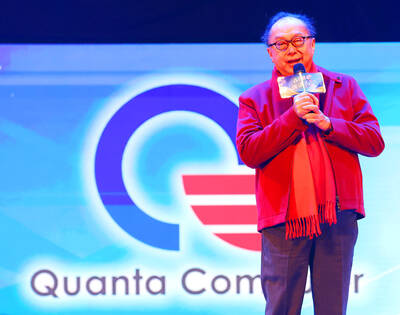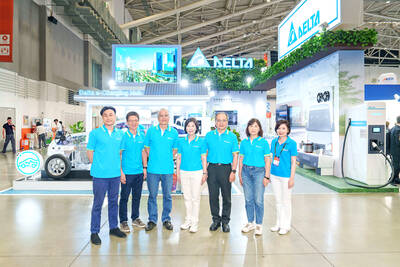Billionaire Henry Sy (施至成), whose retail empire has made him the richest man in the Philippines, may build as many as three malls a year in China to expand in the first major economy to rebound from the global recession.
“We have 34 malls in the Philippines and China is a market that’s 13 times bigger” by population, said Hans Sy (施漢生), president of SM Prime Holdings Inc, a unit of his father’s SM Investments Corp. SM Prime, the biggest Philippine mall operator, is spending 5.5 billion pesos (US$115 million) this year in China.
SM Investments, whose 61 percent share-price gain this year beats the Philippine benchmark, is increasing capital spending for this year by almost a third. Expanding in China may help open opportunities for the family’s other businesses, said Teresita Sy-Coson (施蒂絲), Henry Sy’s eldest child and vice-chairwoman at SM Investments.
“The malls will be an excellent outpost for the group,” said Alex Pomento, Philippine strategist at Macquarie Group Ltd. “They get a gauge of China’s consumer pulse and a springboard for the group’s other businesses.”
Henry Sy, 84, immigrated from China at the age of 12 and built the Philippines’ fourth-biggest listed company from a shoe store he started in 1948, amassing a net worth estimated by Forbes magazine at US$2.7 billion.
“China has a big consumer market, it will continue to evolve,” Henry Sy said in an interview on Saturday, which was also attended by Sy-Coson, Sio and Hans Sy.
“It has improved and can do things better than other countries,” said Sy, who started selling rice, sardines and soap at his father’s Manila store in 1936.
SM Investments gained 1.6 percent to 310 pesos at the noon close in Manila trading, while SM Prime rose 2.2 percent to 9.40 pesos.
SM Investments has outpaced the 38 percent gain of the benchmark Philippine Stock Exchange Index this year. Ayala Corp, holding company of the third-richest Philippine family and owner of the nation’s third-largest mall operator, has climbed 36 percent, advancing by 2.7 percent to 285 pesos yesterday.
SM Prime plans to open one mall annually in China starting next year and may accelerate that pace to as many as three yearly by 2013, Hans Sy said.
“There have been a lot of Chinese provincial officials who have visited the Philippines and they see what we are doing here and they want to replicate that,” Sy-Coson said. “Even now, there are invitations from provincial officials to go into their areas.”
SM Investments, whose assets include the biggest Philippine bank by assets and the Southeast Asian country’s largest supermarket and department store operators, forecasts profit will grow between 12 percent and 14 percent this year, chief financial officer Jose Sio said.
The company kept its target even after the Philippines cut the low end of its economic growth forecast from 3.1 percent to 0.8 percent, the weakest since 1998. Funds sent home by overseas Filipinos are sustaining consumer spending at SM-branded shops and malls, Sy-Coson said.
Remittances, which account for 10 percent of the Philippine economy, grew 2.8 percent to US$6.98 billion in the first five months from a year ago. The inflows reached a record US$16.4 billion last year, 11 times the country’s total net foreign direct investment.
About 20 percent of Philippine consumer spending passes through SM Investments’ malls and stores, and the company captures US$0.33 of every US dollar spent by families of Filipinos working abroad, Macquarie’s Pomento said.
SM Prime seeks to boost the share of its spending in China as it acquires more sites for expansion, Sio said. This year’s investment in China is 46 percent of the 12 billion pesos SM Prime will spend on expansion.
China’s US$3.21 trillion economy is 22 times the Philippines’ US$144 billion. China’s economic growth accelerated to 7.9 percent in the second quarter, while the Philippines slowed to 0.4 percent in the first quarter.
“I am cautiously optimistic about the group’s expansion into China,” said Paul Joseph Garcia, who helps manage US$1.25 billion as chief investment officer at ING Investment Management Ltd in Manila. “China is a very competitive market and hard to penetrate. Even global retailers are not having it easy.”
SM Prime doesn’t sell retail space, preferring long-term recurring rental income to short-term gains, and will apply the same principle in China, said Hans Sy. SM Prime will focus on China’s emerging cities because their development and consumers’ profiles closely resemble those at home, he said.
To draw crowds into its China malls, SM Prime hosts events to mark Valentine’s Day, Halloween and Christmas.
“Little Miss SM” pageants are well received because China’s one-child policy makes it more likely that parents will dote on their children,” Hans Sy said.
“The success we are having now in China is from the formula here in the Philippines,” he said. “Whatever we do here, we do there.”
SM Investments posted record profit of 14 billion pesos last year, on growth at its shopping malls, grocers and department stores. SM Prime’s profit reached a record 6.41 billion pesos last year.
SM Prime, which is adding two more Philippine shopping centers this year after opening one in May, entered China in 2007 after buying Henry Sy’s malls in Xiamen, Jinjiang and Chengdu for US$252 million.
The company will by October double the size of its Xiamen mall, which Henry Sy opened in 2001. It plans to open a shopping center in Suzhou next year, in Chongqing the following year and in Zibo in 2012.
Rolling out one mall a year will allow SM Prime to build up its organization, gain further familiarity with China’s market and prepare for faster expansion in 2013, said Hans Sy.
“The malls will lead the way” for the group’s expansion into China, Sy-Coson said.

Quanta Computer Inc (廣達) chairman Barry Lam (林百里) is expected to share his views about the artificial intelligence (AI) industry’s prospects during his speech at the company’s 37th anniversary ceremony, as AI servers have become a new growth engine for the equipment manufacturing service provider. Lam’s speech is much anticipated, as Quanta has risen as one of the world’s major AI server suppliers. The company reported a 30 percent year-on-year growth in consolidated revenue to NT$1.41 trillion (US$43.35 billion) last year, thanks to fast-growing demand for servers, especially those with AI capabilities. The company told investors in November last year that

Intel Corp has named Tasha Chuang (莊蓓瑜) to lead Intel Taiwan in a bid to reinforce relations between the company and its Taiwanese partners. The appointment of Chuang as general manager for Intel Taiwan takes effect on Thursday, the firm said in a statement yesterday. Chuang is to lead her team in Taiwan to pursue product development and sales growth in an effort to reinforce the company’s ties with its partners and clients, Intel said. Chuang was previously in charge of managing Intel’s ties with leading Taiwanese PC brand Asustek Computer Inc (華碩), which included helping Asustek strengthen its global businesses, the company

Taiwanese suppliers to Taiwan Semiconductor Manufacturing Co. (TSMC, 台積電) are expected to follow the contract chipmaker’s step to invest in the US, but their relocation may be seven to eight years away, Minister of Economic Affairs J.W. Kuo (郭智輝) said yesterday. When asked by opposition Chinese Nationalist Party (KMT) Legislator Niu Hsu-ting (牛煦庭) in the legislature about growing concerns that TSMC’s huge investments in the US will prompt its suppliers to follow suit, Kuo said based on the chipmaker’s current limited production volume, it is unlikely to lead its supply chain to go there for now. “Unless TSMC completes its planned six

Power supply and electronic components maker Delta Electronics Inc (台達電) yesterday said it plans to ship its new 1 megawatt charging systems for electric trucks and buses in the first half of next year at the earliest. The new charging piles, which deliver up to 1 megawatt of charging power, are designed for heavy-duty electric vehicles, and support a maximum current of 1,500 amperes and output of 1,250 volts, Delta said in a news release. “If everything goes smoothly, we could begin shipping those new charging systems as early as in the first half of next year,” a company official said. The new